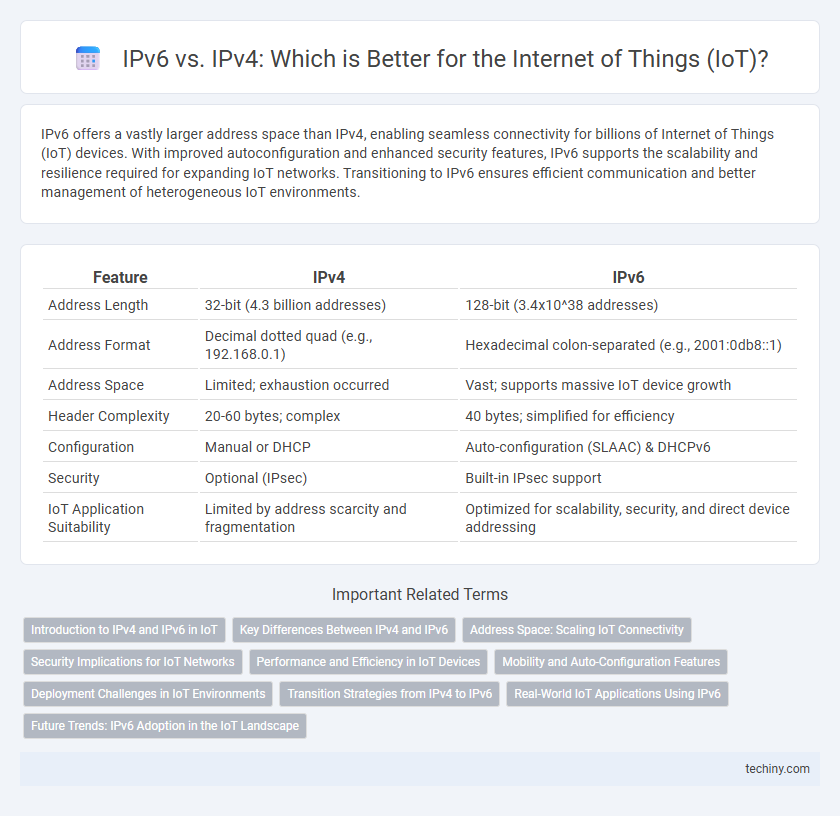IPv6 offers a vastly larger address space than IPv4, enabling seamless connectivity for billions of Internet of Things (IoT) devices. With improved autoconfiguration and enhanced security features, IPv6 supports the scalability and resilience required for expanding IoT networks. Transitioning to IPv6 ensures efficient communication and better management of heterogeneous IoT environments.
Table of Comparison
| Feature | IPv4 | IPv6 |
|---|---|---|
| Address Length | 32-bit (4.3 billion addresses) | 128-bit (3.4x10^38 addresses) |
| Address Format | Decimal dotted quad (e.g., 192.168.0.1) | Hexadecimal colon-separated (e.g., 2001:0db8::1) |
| Address Space | Limited; exhaustion occurred | Vast; supports massive IoT device growth |
| Header Complexity | 20-60 bytes; complex | 40 bytes; simplified for efficiency |
| Configuration | Manual or DHCP | Auto-configuration (SLAAC) & DHCPv6 |
| Security | Optional (IPsec) | Built-in IPsec support |
| IoT Application Suitability | Limited by address scarcity and fragmentation | Optimized for scalability, security, and direct device addressing |
Introduction to IPv4 and IPv6 in IoT
IPv4, with its 32-bit addressing scheme, supports approximately 4.3 billion unique addresses, which limits its scalability for the vast number of IoT devices. IPv6, featuring a 128-bit address space, offers an almost unlimited number of unique IP addresses, enabling seamless connectivity and efficient device identification in IoT networks. The transition from IPv4 to IPv6 is critical to accommodate the exponential growth of connected IoT devices and to support advanced features like improved security and auto-configuration.
Key Differences Between IPv4 and IPv6
IPv6 offers a vastly larger address space with 128-bit addresses compared to IPv4's 32-bit, enabling billions of devices in the Internet of Things ecosystem to connect seamlessly. IPv6 incorporates simplified header structures and built-in security features like IPsec, enhancing performance and security over the older IPv4 protocol. Automatic address configuration and improved multicast routing in IPv6 further optimize IoT device communication and network efficiency.
Address Space: Scaling IoT Connectivity
IPv6 offers an expansive address space with 3.4 x 10^38 unique IP addresses, vastly surpassing IPv4's limited 4.3 billion addresses, enabling seamless scaling of IoT connectivity. This massive address capacity supports the exponential growth of connected devices in smart cities, industrial automation, and home automation systems. The extensive IPv6 address pool eliminates the need for Network Address Translation (NAT), enhancing end-to-end communication efficiency and security in IoT networks.
Security Implications for IoT Networks
IPv6 enhances IoT network security by supporting IPsec natively, providing end-to-end encryption and authentication essential for device communication. Unlike IPv4, IPv6 eliminates the need for network address translation (NAT), simplifying secure peer-to-peer connections and reducing attack surfaces. The expanded address space in IPv6 also aids in implementing unique addresses for billions of IoT devices, improving traceability and mitigating risks of IP spoofing.
Performance and Efficiency in IoT Devices
IPv6 enhances performance and efficiency in IoT devices by providing a vastly larger address space, eliminating the need for Network Address Translation (NAT), which reduces latency and simplifies direct device communication. Its built-in support for multicast and auto-configuration optimizes network resource utilization and simplifies device management in large-scale IoT deployments. IPv4's limited address pool and reliance on NAT can introduce bottlenecks and inefficiencies, making IPv6 the preferred protocol for scalable, high-performance IoT networks.
Mobility and Auto-Configuration Features
IPv6 offers enhanced mobility support in Internet of Things (IoT) networks through features like Mobile IPv6, enabling seamless device movement across different networks without losing connectivity. Its stateless address auto-configuration (SLAAC) simplifies device configuration by allowing IoT devices to self-assign IP addresses without requiring a DHCP server. In contrast, IPv4 lacks native mobility protocols and relies heavily on external mechanisms for address configuration, limiting scalability and flexibility in dynamic IoT environments.
Deployment Challenges in IoT Environments
IPv6 deployment in IoT environments faces challenges such as device compatibility issues, limited legacy infrastructure support, and the complexity of transitioning from IPv4 networks. Addressing these barriers requires comprehensive network upgrade strategies and robust security protocols tailored for heterogeneous IoT devices. Seamless integration hinges on efficient address allocation mechanisms and interoperability standards that accommodate the massive scale of IoT deployments.
Transition Strategies from IPv4 to IPv6
Transition strategies from IPv4 to IPv6 involve mechanisms such as dual-stack implementation, tunneling protocols like 6to4 and Teredo, and Network Address Translation 64 (NAT64). Dual-stack allows devices to run IPv4 and IPv6 simultaneously, facilitating gradual migration without service interruption. Tunneling encapsulates IPv6 packets within IPv4 networks, enabling communication across legacy infrastructure while NAT64 translates IPv6 requests to IPv4 servers, supporting interoperability during the transition in Internet of Things deployments.
Real-World IoT Applications Using IPv6
IPv6 offers a vastly larger address space essential for scalable IoT deployments, enabling billions of connected devices in smart cities, healthcare monitoring, and industrial automation. Real-world IoT applications leverage IPv6's improved security features and seamless device-to-device communication for enhanced data transmission and reduced latency. Adoption of IPv6 in IoT ensures efficient network management and supports emerging technologies like edge computing and 5G integration.
Future Trends: IPv6 Adoption in the IoT Landscape
IPv6 adoption in the IoT landscape is accelerating due to its vast address space, essential for the exponential growth of connected devices. Enhanced security features and improved network autoconfiguration capabilities further drive IPv6 integration in IoT ecosystems. Industry forecasts predict that IPv6 will become the standard protocol for IoT connectivity, enabling scalable and efficient device communication.
IPv6 vs IPv4 Infographic

 techiny.com
techiny.com